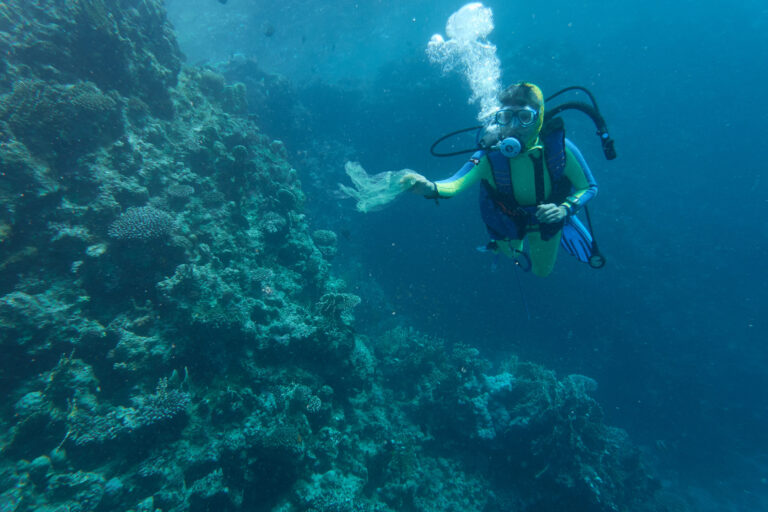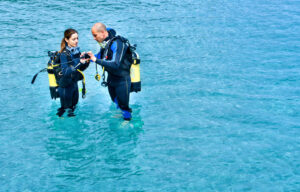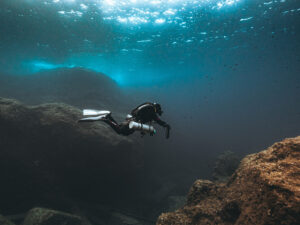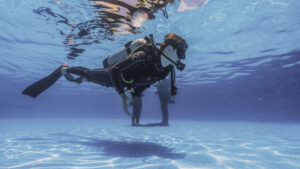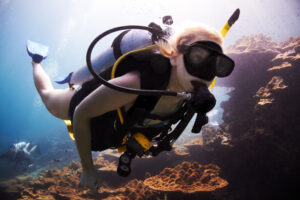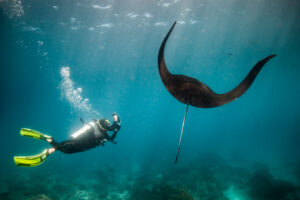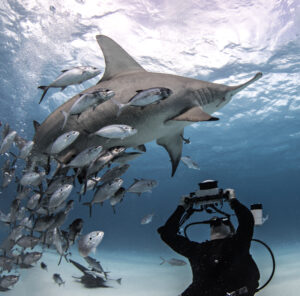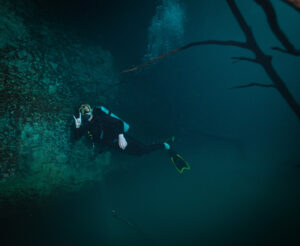What is the Frenzel Maneuver?
The Frenzel Maneuver is a specialized technique used primarily in scuba diving and freediving to equalize pressure in the middle ear. Named after the German Luftwaffe commander Hermann Frenzel who developed it during World War II, this maneuver has become a crucial skill for divers. Proper equalization prevents discomfort and potential damage to the ear caused by changes in pressure during descents and ascents in water. The Frenzel Maneuver involves closing the vocal cords and using the tongue to compress air into the Eustachian tubes, allowing for more effective pressure regulation compared to other methods.
Historical Background
The Frenzel Maneuver’s origins date back to the early 20th century, developed out of necessity during World War II. Hermann Frenzel, a commander in the German Luftwaffe, devised the technique to help pilots equalize pressure changes experienced during rapid altitude shifts. Although initially intended for aviation, the maneuver was quickly adopted by the diving community due to its effectiveness.
Throughout the mid-20th century, the Frenzel Maneuver gained popularity among divers as they sought more efficient ways to equalize ear pressure. Traditional methods, such as the Valsalva Maneuver, were often less effective and could lead to complications. As diving technology and techniques advanced, the Frenzel Maneuver became a standard practice, especially among technical and deep divers.
Prominent figures in the diving community, such as Jacques Cousteau, played a significant role in promoting and refining the Frenzel Maneuver. Their work in underwater exploration and documentary filmmaking brought attention to the importance of proper equalization techniques, further cementing the Frenzel Maneuver’s place in diving history. Today, it is widely taught in diving courses and is considered an essential skill for safe and effective diving.
Physiological Basis
The human ear is a complex structure that plays a vital role in maintaining balance and hearing. When diving, changes in ambient pressure can significantly affect the ear, making equalization necessary to avoid discomfort and injury. Understanding the physiological basis of the Frenzel Maneuver involves a closer look at the ear’s anatomy and the mechanics of pressure changes.
The ear comprises three main parts: the outer ear, the middle ear, and the inner ear. The outer ear includes the visible part of the ear and the ear canal, which directs sound waves to the eardrum. The middle ear, located behind the eardrum, contains the ossicles—three tiny bones that transmit sound vibrations to the inner ear. The Eustachian tube, connecting the middle ear to the back of the nose and throat, plays a crucial role in equalizing pressure.
During a dive, as the diver descends, the surrounding water pressure increases. This increase in pressure can cause the eardrum to push inward, leading to discomfort and potential damage if not equalized. The Frenzel Maneuver addresses this issue by allowing divers to equalize the pressure in their middle ear without straining or causing additional problems.
When performing the Frenzel Maneuver, the diver closes their vocal cords, creating a sealed chamber in the throat. The tongue is then used to compress air against the closed vocal cords and direct it into the Eustachian tubes. This action effectively equalizes the pressure in the middle ear with the external water pressure, preventing discomfort and potential injury.
Step-by-Step Description of the Frenzel Maneuver
Performing the Frenzel Maneuver requires precision and practice to master. The following steps outline the process in detail, ensuring that divers can effectively equalize their ear pressure.
First, the diver should position their tongue in a way that the back of the tongue touches the soft palate, similar to making a “K” or “G” sound. This positioning is crucial for creating the necessary air pressure.
Next, the diver needs to close their vocal cords. This step is akin to preparing to lift a heavy weight or trying to prevent air from escaping when inflating a balloon with the mouth closed. The closure of the vocal cords creates a sealed chamber in the throat.
With the vocal cords closed, the diver uses the tongue to compress the air. By moving the tongue upward and backward against the closed vocal cords, the air is directed into the Eustachian tubes. This action equalizes the pressure in the middle ear with the external environment.
Common mistakes when performing the Frenzel Maneuver include failing to close the vocal cords properly or not using the tongue effectively to compress the air. These errors can result in ineffective equalization and potential discomfort. Divers are encouraged to practice these steps on land before attempting them underwater to ensure they have mastered the technique.
Applications in Diving
The Frenzel Maneuver is particularly useful in several diving scenarios. It is most beneficial during rapid descents, where pressure changes occur quickly, and precise equalization is crucial. Unlike the Valsalva Maneuver, which involves forceful exhalation against closed nostrils, the Frenzel Maneuver is gentler and more controlled, reducing the risk of barotrauma.
Technical divers, who often operate at greater depths and face more extreme pressure changes, rely heavily on the Frenzel Maneuver. The technique’s effectiveness in handling significant pressure differences makes it a preferred choice among this group of divers. Additionally, freedivers, who descend without breathing apparatus, benefit from the Frenzel Maneuver’s efficiency, allowing them to equalize pressure with minimal effort.
Compared to other equalization techniques, the Frenzel Maneuver offers several advantages. It requires less physical exertion and is less likely to cause complications such as over-pressurization of the middle ear. This makes it suitable for divers of all levels, from beginners to experienced professionals.
By mastering the Frenzel Maneuver, divers can enhance their safety and enjoyment underwater. Effective equalization reduces the risk of ear injuries, allowing for longer and more comfortable dives. It also enables divers to focus on their surroundings and tasks, rather than dealing with the discomfort of pressure changes.
Training and Practice
Learning the Frenzel Maneuver can be challenging, but with proper guidance and practice, divers can master this essential skill. Beginners are advised to start by understanding the anatomy involved and the mechanics of the maneuver. Visualization exercises, where the diver imagines the process step-by-step, can be helpful in grasping the concept.
Practical exercises on land are crucial for building muscle memory. One recommended drill is to practice closing the vocal cords and positioning the tongue correctly. This can be done by making the “K” or “G” sound repeatedly until it becomes second nature. Once comfortable with these steps, the diver can simulate the maneuver by compressing air with the tongue while keeping the vocal cords closed.
Another effective exercise involves using a mirror to observe the movement of the tongue and throat muscles. This visual feedback can help divers refine their technique and ensure they are performing the maneuver correctly. Instructors often use tools like nasal balloons to provide resistance, helping divers feel the pressure change and understand the force required for equalization.
Enrolling in a diving course that covers the Frenzel Maneuver is highly recommended. Certified instructors can provide personalized guidance, correct mistakes, and offer advanced tips for mastering the technique. Training in a controlled environment, such as a pool, allows divers to practice equalization without the added stress of open water conditions.
Regular practice and repetition are key to mastering the Frenzel Maneuver. Divers should incorporate the maneuver into their routine warm-up exercises, ensuring it becomes an automatic response during dives. Over time, this consistent practice will lead to more effective and reliable equalization.
Health and Safety Considerations
While the Frenzel Maneuver is an effective technique for equalizing ear pressure, it is essential to understand the potential risks and safety considerations associated with its use. Improper equalization can lead to barotrauma, a condition where pressure differences cause damage to the ear structures.
Barotrauma can manifest as pain, discomfort, and hearing loss. In severe cases, it can result in a ruptured eardrum or damage to the inner ear, leading to long-term complications. Symptoms of barotrauma include a feeling of fullness in the ear, dizziness, and ringing in the ears (tinnitus). Divers should be vigilant for these signs and take immediate action if they occur.
To prevent barotrauma, divers must ensure they are performing the Frenzel Maneuver correctly. This includes closing the vocal cords properly, using the tongue to compress air effectively, and equalizing frequently during descents and ascents. It is crucial to equalize early and often, rather than waiting until discomfort is felt, as this can reduce the risk of injury.
If barotrauma symptoms occur, divers should stop their descent and attempt to equalize. If the symptoms persist, they should ascend slowly and seek medical attention if necessary. Avoiding forceful or aggressive equalization techniques is essential, as these can exacerbate the condition.
Mastering the Frenzel Maneuver can enhance diver safety by providing a reliable and effective method for pressure equalization. By following proper techniques and being mindful of their body’s signals, divers can minimize the risk of ear injuries and enjoy a safer and more comfortable experience underwater.
Key Takeaways
The Frenzel Maneuver is a critical skill for divers, enabling effective equalization of ear pressure during dives. Understanding the physiological basis, mastering the technique through practice, and being aware of health and safety considerations are essential for utilizing this maneuver successfully. Whether for recreational or technical diving, the Frenzel Maneuver contributes to a safer and more enjoyable underwater experience.

